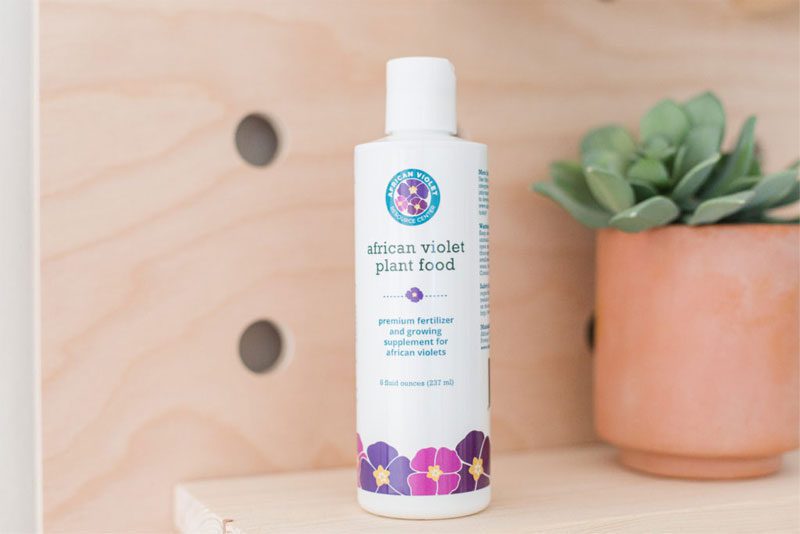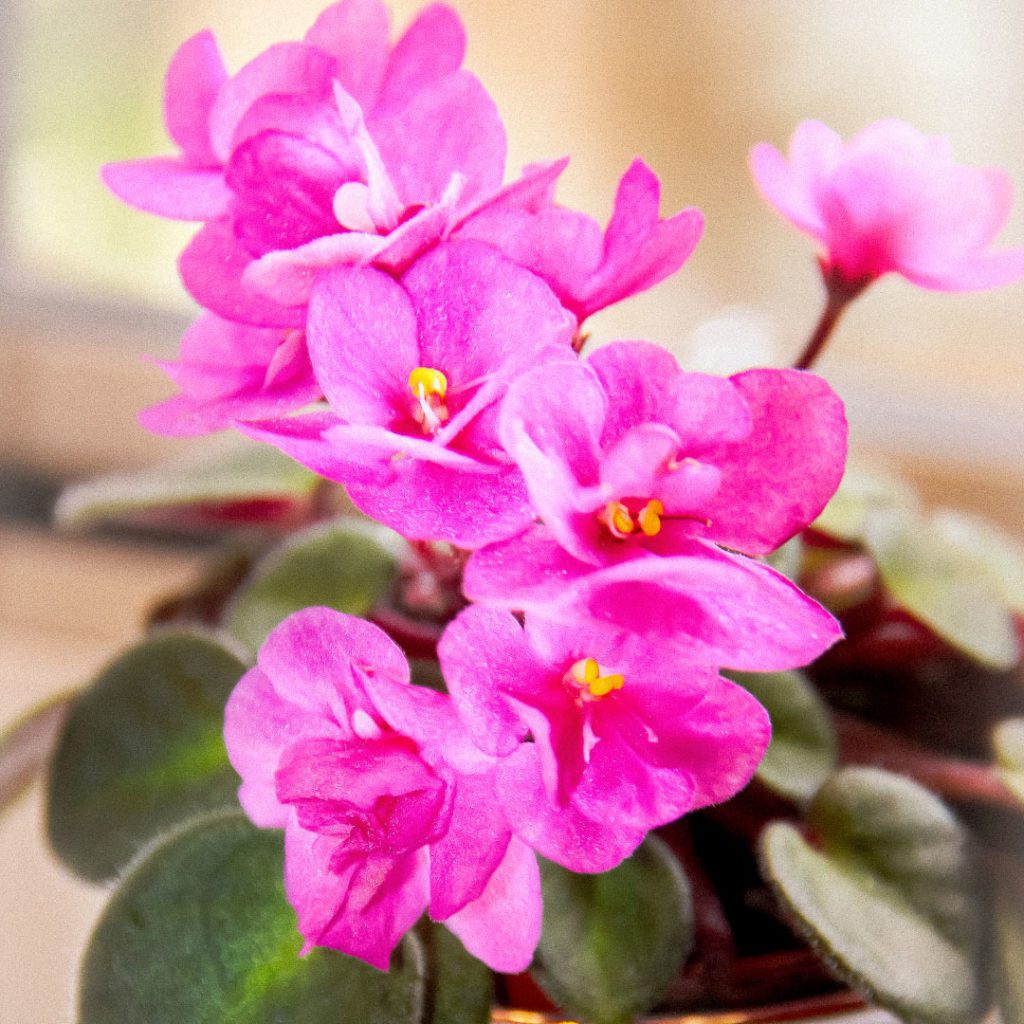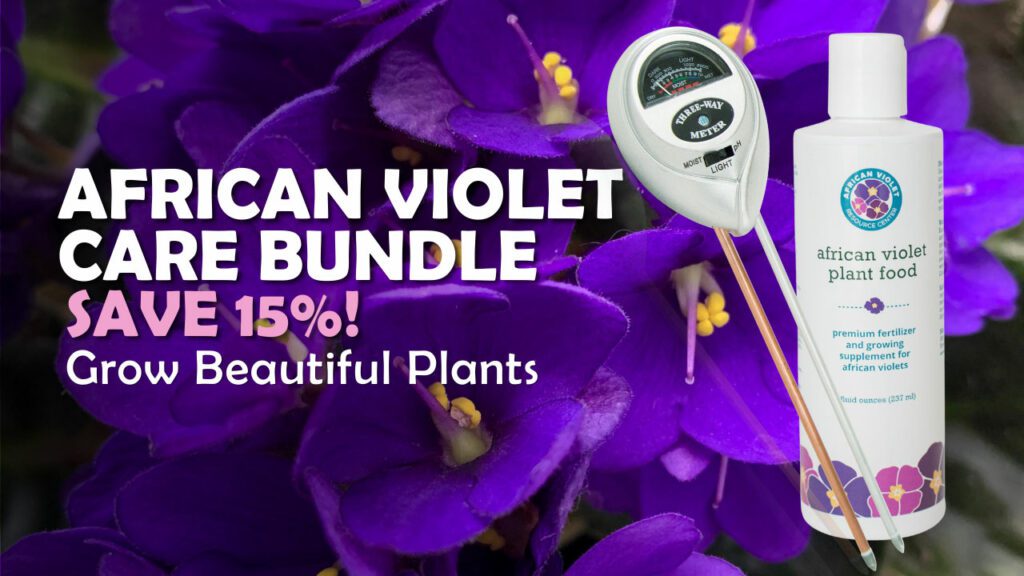In terms of looks and care, miniature African violets are very similar to regular African violets. The different classifications of African violets from smallest to largest are miniature, semi-miniature, standard, and large.
All sizes of African violets are relatively easy to grow and produce beautiful foliage and blooms. The biggest advantage to miniature African violets is that they are perfect for growing in smaller spaces, and they’re also great for terrariums or for growers who want to have as many different specimens of African violets as possible without taking up as much room.
Mini African Violet Guide
Miniature African violets are hybrids of Saintpaulia ionantha, a plant first found in the wild in Tanzania. As plant lovers began growing and falling in love with this enchanting plant, breeders quickly began developing new varieties, including miniature African violets.
Height & Spread
Miniature African violets generally grow to between 3 to 6 inches in diameter and usually don’t get any taller than 6 inches in height.
Seasonality & Life Span
Like their larger counterparts, miniature African violets can bloom 10-12 months of the year under the correct conditions. They also have a similarly long life span of up to 50 years if properly taken care of.
While miniature African violets may be small, they have all the vitality of standard African violets as long as you provide the care they require.
Color of Blooms
If you’re looking to add mini African violets to your collection, you have plenty of options. They come in all kinds of colors, including blue, violet, lavender, pink, red, and white—and all combinations in between. Some mini African violets have one color while others have two or more.
Their blooms have all manner of patterns as well as a wide range of shapes and sizes.
Miniature African Violet Varieties
There’s an almost endless number of African violet varieties, making it hard to know where to start when it comes to picking out the miniature African violet you want. You can find varieties with basically any type of bloom and foliage that interests you. Here are a few we particularly like, but there are many more miniature African violet varieties out there.
Persian Prince: This beautiful miniature variety has blue blooms with medium-green scalloped foliage. The foliage by itself would be attractive enough, but with the added beauty of the blue flowers, this variety stands out in any collection.
Pixie Blue: This miniature variety has deep purple-blue flowers and its foliage is a bit more traditional with a dark-green color. The variety is a trailing African violet, so it looks particularly beautiful when allowed to spill over the edge of its container.
Rose Quartz: This miniature variety has pale pink blooms with dark, oval foliage. The contrast between the light blooms and darker foliage is very attractive.
Peacock: This miniature variety has stunning ruffled flowers that are mostly purple with swatches of pink mixed in. There’s a reason this variety is called “peacock”—it’s guaranteed to draw attention.
Zivay (Morev): This miniature variety has masses of frilly, pink blooms. By themselves, the blooms are beautiful, but this lovely variety also has variegated leaves with a dark-green center that slowly transitions to white at the edges. If you’re looking for a unique African violet for your collection, this one definitely fits the bill.
What Is the Smallest African Violet?
The smallest type of African violet is called a micro-miniature. These varieties have a diameter of 2 inches or less. If you’re searching for a truly tiny African violet, look for a micro-miniature.
Miniature African Violets Care Guide
Caring for miniature African violets is very similar to caring for standard or large African violets. If you get the lighting and watering correct, you will generally have beautiful miniature African violets. However, there are a couple of things that differ for miniature African violets, particularly when it comes to potting them correctly.
Here’s what you need to know.
Light
Light is one of the most difficult things to get right for African violets. While this plant can survive in low levels of light, it won’t bloom without many hours of sunlight a day. This means that if you want your African violets to bloom 10-12 months each year, you’ll need to find the sunniest indoor spot for them. This is usually a window facing north or east.
How many hours of sunlight do African violets need?
To keep blooming, your African violet needs at least 10 hours of sunlight a day. During the winter months, you may need to use artificial lights to supplement the amount of light it receives.
Of course, if your home doesn’t receive enough sunlight and you don’t want to use artificial lights, you don’t have to. African violets will start blooming again once the daylight hours get longer.
Temperature & Humidity
Part of the reason African violets are such popular houseplants is because they do very well in normal household conditions. They thrive when the temperature is around 70 degrees Fahrenheit, which is the average temperature in most homes. As long as the temperature is between 60-80 degrees Fahrenheit, African violets are happy.
In their native environment, African violets enjoy humidity levels between 70-80%. This is higher than the humidity levels should be in your home, however, African violets do just fine when the humidity levels are between 50-60%, which is realistic for most homes.
If you live somewhere with low humidity levels, you may need to use a humidifier for your African violets, especially during the winter.
Watering
Watering African violets correctly is important to keep them healthy. Overwatering is the most common reason African violets die. Soil that remains wet for too long can suffocate your African violet’s roots, and overly wet soil also allows disease and fungus to develop.
Only water your miniature African violets once the soil has dried out. This typically happens about once a week depending on the temperature and the season. Of course, since miniature African violets are in tiny pots, their soil dries out a little faster than standard African violets.
When the top ½ inch of the soil is completely dry, it’s time to water. Bottom water your plants to keep water from splashing on the leaves and creating spots. Although these spots don’t harm your African violet, they look unattractive.

Fertilizing
Your miniature African violet will likely need fertilizer to thrive. After all, miniature African violets only have access to a tiny amount of soil, so they use up those nutrients and then have no other way to get additional nutrients.
You won’t need to fertilize right away, though. After potting or repotting, the soil should have enough nutrients to allow you to wait several months before fertilizing. Once it’s time to add fertilizer, use a small amount of one with a balanced NPK ratio. Balanced fertilizers will show formulas on the package where all numbers are the same, like 10-10-10 or 15-15-15.
We suggest using a liquid fertilizer such as African Violet Plant Food. Liquid fertilizer is easy to use when watering and allows you to have control over how much fertilizer you use. Fertilize about once a week.
When you first start fertilizing, use about half as much fertilizer as recommended. It’s easy to over-fertilize miniature African violets. Too much fertilizer can kill plants, so it’s better to start off being cautious. You can always add more fertilizer later if you need to.
Flowering
Miniature African violets will flower when they receive enough sunlight. If your African violet is receiving enough light, is being watered properly, and has the nutrients it needs, you’ll likely have blooms 10-12 months out of the year.
Deadheading
While deadheading won’t make your African violet bloom more profusely, there’s no reason to leave dead flowers on your plant. Carefully removing dead flowers from your plant enhances your African violet’s appearance.
Pot Size & Repotting
Periodically repotting is necessary to refresh the soil. It’s also a great time to check to see that your African violet has healthy roots. Generally, African violets are repotted about once a year. Some African violet owners repot twice a year, but you don’t have to repot this often.
When repotting, you should use fresh soil, trim any damaged roots, and determine whether or not it’s time to move your miniature African violet to a larger container.
When repotting miniature African violets, pay attention to the diameter of the pot you’re using. Most miniature African violets need a pot that is 1½ inch or 2 inches in diameter. The general guideline is that the diameter of the plant should be about 3 times the diameter of the pot. So, a miniature African violet with a diameter of 3 inches should be in a 1-inch pot.
This may seem small, but African violets don’t need much extra room for their roots. Planting them in pots that are too large just allows excess water to remain in the soil, which can lead to root rot.
Propagation
Miniature African violets are easy to propagate. Even though they have tiny stems and leaves, they can be propagated by leaf easily.
Carefully remove healthy leaves from the middle row branching out from the crown using sharp scissors. Keep about 1 to ½ inch of the stem attached to the leaf, and place the leaf in a shallow container filled with growing medium. Water allows any excess water to drain away. Then place a plastic bag over the container to keep moisture in.
When placed in a sunny spot, you can expect the cutting to begin forming roots in about 3-4 weeks. New leaves will develop after about 6-8 weeks.
Consider propagating several cuttings at once just in case some cuttings don’t survive. You can always share any extra plants later. Propagation is a great way to expand your African violet collection or to make new plants to share and swap with other African violet lovers.
Pests and Diseases
Miniature African violets can sometimes suffer from pests and diseases. However, as long as you take proper care of your African violets, it’s unlikely you’ll have any issues. There are two keys to avoiding most pests and diseases that affect African violets.
First, make sure you don’t overwater your plants or allow excess water to remain in the soil, which weakens African violet roots and allows diseases to develop. Second, check new African violets for pests and diseases before bringing them into your home. Pests and disease can easily spread from one plant to another, so make sure you aren’t accidentally introducing anything harmful to the rest of your plants when you get a new plant.
Here are the most common pests and diseases that affect miniature African violets:
- Crown and root rot: Miniature African violets are susceptible to developing both crown rot and root rot—overwatering causes both problems. Wait until the soil has dried out before watering your African violet. Also, always be sure that excess water can easily drain from your plant’s container.
- Mites: These tiny pests cause huge problems when they attack African violets. Because they’re so small, you won’t be able to see them, but you’ll notice their effects as your African violets develop curling and stunted leaves. Use a miticide to get rid of the pests on infected plants. Stopping a mite infestation is difficult, so many people throw away infected African violets rather than spending the time dealing with the mites.
- Mealybugs: Another small pest, these bugs are about ¼ inch long and have a white, waxy exterior. You can use insecticides to treat mealybugs, but just like with mites, it’s not easy to stop a mealybug infestation. It’s easier to get rid of infected African violets rather than risk having mealybugs spread to healthy plants.
Join the African Violet Club!
Whether you’re just starting out or are a seasoned grower, African Violet Resource Center has everything you need to help your plant grow vibrant and strong. Explore our other articles, visit our online shop, and connect with other houseplant lovers in our Facebook group to learn everything you need to know about this rewarding hobby!
More Great African Violet Resources
Best African Violet Plant Stands and Pots
Saintpaulia Ionantha African Violet Care Guide







